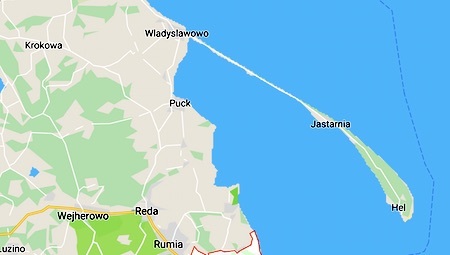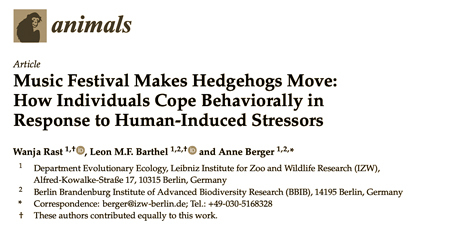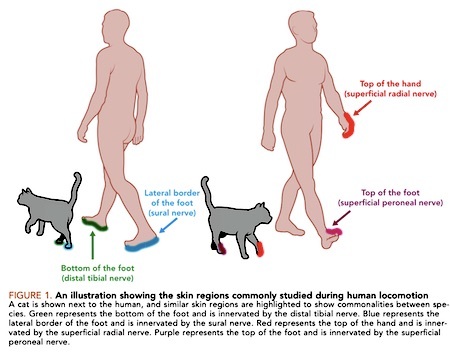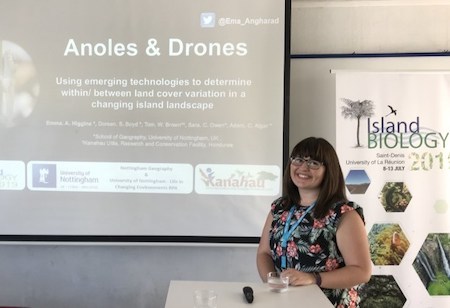Marc Abrahams's Blog, page 136
September 30, 2019
Quantifying Missing Drizzle – a new paradigm [study]
 If a raindrop is less than 0.5mm in diameter, it’s drizzle – and if a drizzle particle is over 0.5mm, it’s a raindrop. That’s following the definitions of the National Weather Service Observing Handbook No. 8, Aviation Weather Observations for Supplementary Aviation Weather Reporting Stations (SAWRS), Manual Observations, October 1996. But quantifying drizzle is not as straightforward as simply collecting raindrops in a disdrometer, [see photo] because drizzle doesn’t (necessarily) ‘fall’ in a predictable way, as rain (sometimes) does, In short, Disdrometers have difficulty with drizzle :
If a raindrop is less than 0.5mm in diameter, it’s drizzle – and if a drizzle particle is over 0.5mm, it’s a raindrop. That’s following the definitions of the National Weather Service Observing Handbook No. 8, Aviation Weather Observations for Supplementary Aviation Weather Reporting Stations (SAWRS), Manual Observations, October 1996. But quantifying drizzle is not as straightforward as simply collecting raindrops in a disdrometer, [see photo] because drizzle doesn’t (necessarily) ‘fall’ in a predictable way, as rain (sometimes) does, In short, Disdrometers have difficulty with drizzle :
“Commonly used disdrometers tend not to accurately measure concentrations of very small drops in the raindrop size distribution (DSD), either through truncation of the DSD at the small-drop end or because of large uncertainties on these measurements. Recent studies have shown that, as a result of these inaccuracies, many if not most ground-based disdrometers do not capture the ‘drizzle mode’ of precipitation, which consists of large concentrations of small drops and is often separated from the main part of the DSD by a shoulder region.”
– explains a report in the Journal of Applied Meteorology and Climatology, Jan. 2019. The authors propose a solution to such problems :
“We present a technique for reconstructing the drizzle mode of the DSD from ‘incomplete’ measurements in which the drizzle mode is not present.”
See: Reconstructing the Drizzle Mode of the Raindrop Size Distribution Using Double-Moment Normalization, Journal of Applied Meteorology and Climatology, Jan. 2019
Note: If the water droplet size is below 20 micrometers (or so) it’s not drizzle, it’s fog. [Ref : Pruppacher H., Klett J. (2010) Microstructure of Atmospheric Clouds and Precipitation. In: Microphysics of Clouds and Precipitation. Atmospheric and Oceanographic Sciences Library, vol 18.]
BONUS: The internationally recognized symbols for drizzle(s) can be found here.
Photo: Courtesy Wikipedia
Research research: Martin Gardiner

September 27, 2019
What happens at an Improbable Dramatic Readings session
Improbable Dramatic Readings is (or are) one of the kinds of events we’ve invented. Here’s video of the Improbable Dramatic Readings session at Arisia, in January 2019.
This particular session included:
Dramatic readings from (real) improbable research studies. The dramatic readers: Gary Dryfoos, Sonya Taaffe, Jeremy Bell. Michele Liguori, Geri Sullivan, human spotlight Jim Bredt, and an unnamed timer also are featured.
Also: The world premiere performance of the chorus-enhanced version of William Topaz McGonagall ‘s disastrous poem “The Tay Bridge Disaster.” (This poem, in this enhanced version, was performed again later in the year in Ig Nobel shows in England.)
You may wonder why the performers repeatedly refer to music. There was an event in an adjoining hall that involved loud music which would sometimes become overpoweringly audible in the hall where we performed. Happily for you, dear video watcher, that music did not get nearly as distractingly picked up in this recording.
(Thanks to David Kessler for arranging this event from 3000 miles away.)

September 26, 2019
Ig Nobel Peace Prize winner Jacques Chirac has died
Jacques Chirac, who was awarded the 1996 Ig Nobel Peace Prize, has died. A news report in DW says: “The former French president, Jacques Chirac, has died ‘peacefully’ at the age of 86, his family said.’
The 1996 Ig Nobel Peace Prize was awarded to Jacques Chirac, President of France, for commemorating the fiftieth anniversary of Hiroshima with atomic bomb tests in the Pacific.

Will you go to Hel?
Will you go to Hel? If you go to Pomerania, specifically to the Hel Peninsula, and then go alllllllllllllllllll the way to the tip of that peninsula, you will find yourself in the town of Hel. Good luck, voyager!
Here is a tourism photograph of Hel:
Need a map? Here’s one.
You might notice that the Hel Peninsula is not far from Puck. Yet Puck is a long way from Hel. Make of that what you will.
BONUS FACT (unrelated): The 1994 Ig Nobel Prize for mathematics was awarded to the he Southern Baptist Church of Alabama, mathematical measurers of morality, for their county-by-county estimate of how many Alabama citizens will go to Hell if they don’t repent. The railway station master in Hell, Norway sent greetings that were delivered at that year’s Ig Nobel Prize ceremony by the Norwegian consul to Boston.

September 25, 2019
Hedgehogs at a Music Festival
While others study pictures at an exhibition, Wanja Rast, Leon M.F. Barthel, and Anne Berger study hedgehogs at a music festival.
They wrote this report about it: “Music festival makes hedgehogs move: How individuals cope behaviorally in response to human-induced stressors,” Wanja Rast, Leon M.F. Barthel, and Anne Berger, Animals, IX/7 [2019] pp. 2–19. (Thanks to Jim Cowdery for bringing this to our attention.)
The authors at Leibniz Institute for Zoo and Wildlife Research (IZW) and the Berlin Brandenburg Institute of Advanced Biodiversity Research (BBIB), Germany, report:
“We remotely observed eight hedgehogs in a Berlin city park before and during a music festival using measuring devices attached to their bodies. While the actual festival only lasted two days (with about 70,000 visitors each day), setting the area up and removing the stages and stalls took 17 days in total. Construction work continued around the clock, causing an increase in light, noise and human presence throughout the night. In response, the hedgehogs showed clear changes in their behavior in comparison to the 19-day period just before the festival. We found, however, that different individuals responded differently to these changes in their environment. This individuality and behavioral flexibility could be one reason why hedgehogs are able to live in big cities.”

September 24, 2019
Wearing High Heels as Female Mating Strategy [research study]
Comes a major advance, possibly, in the understanding of why some women wear high heeled shoes. A new study presents details:
“Wearing High Heels as Female Mating Strategy,” Pavol Prokop and Jana Švancárová, Personality and Individual Differences, vol. 152, January 2020, 109558. The authors, at Comenius University and at the Slovak Academy of Science, Slovakia, explain: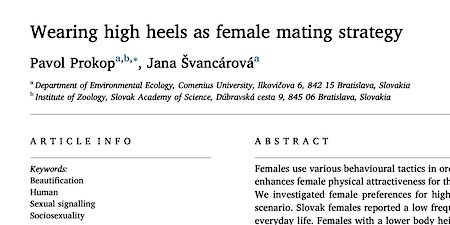
This suggests that females strategically wear high heels when anticipating an interaction with an attractive male and in all probability avoid wearing high heels when anticipating an interaction with a relatively unattractive male….
The results of the present research are based on a specific homogeneous sample of young Slovak females. Future research should further investigate the preference for high heels with data from larger, more diverse samples, because the more divergent the cultures being considered, the stronger the case for universality.
BONUS (possibly unrelated): High Heels and Schizophrenia

September 23, 2019
Walking the walk: Are we not cats, more or less?
A new review study creeps and leaps upon a physiological resemblance of cats and humans.
The study is: “We Are Upright-Walking Cats: Human Limbs as Sensory Antennae During Locomotion,” Gregory E.P. Pearcey and E. Paul Zehr, Physiology, epub 2019.
The authors, at the University of British Columbia and the University of Victoria, explain in un-catlike words:
“Humans and cats share many characteristics pertaining to the neural control of locomotion, which has enabled the comprehensive study of cutaneous feedback during locomotion. Feedback from discrete skin regions on both surfaces of the human foot has revealed that neuromechanical responses are highly topographically organized and contribute to ‘sensory guidance’ of our limbs during locomotion.”
BONUS (perhaps distantly related): The 2017 Ig Nobel Prize for physics was awarded to Marc-Antoine Fardin, for using fluid dynamics to probe the question “Can a Cat Be Both a Solid and a Liquid?” Details of that research are in the study “On the Rheology of Cats,” Marc-Antoine Fardin, Rheology Bulletin, vol. 83, 2, July 2014, pp. 16-17 and 30.

Of talking plants (and paperclips) [study]
Microsoft – the company that created ‘Clippit’ (a.k.a. ‘Clippy’) the conversational paperclip, is continuing its research into non-human communication – with a project that encourages talking with plants.
“If plants could talk to us, what would they say? Equally important how might they respond to us if we could converse with them?”
– asked a 2017 research report from Microsoft – regarding their project named ‘Florence’.
“When you visit Project Florence, you begin by typing a message to it on a Microsoft Surface tablet that is connected to the plant ecosystem. What you type is then sent to a cloud service hosted in Azure, which uses Natural Language Processing to examine the sentiment and the sentence structure, and this is then translated into stimuli (in this case: different light frequencies and durations) that the plant can understand and react to. […]
Florence then ‘replies’ to you with a sentence or two provided by the Azure cloud service, using sample words and phrases collected from Twitter that are of a similar context to your message and possibly found in botanical and/or environmental contexts.”
Florence, says the research team, has built-in personality traits too :
“Florence can be quite cranky and unpleasant if she is too dry or does not care for your input.”
See: Project Florence: A Plant to Human Experience published in : 2017 CHI Conference Extended Abstracts on Human Factors in Computing Systems.
Coming soon: Turning plants into cyborgs
Research research by Martin Gardiner

September 21, 2019
Offered for scale: Child and Wombat Gear
Winners of 2019 Ig Nobel Physics Prize showed up to accept the prize, dressed as a wombat, or as pieces of wombat feces (they received the prize for researching and publishing, “How Do Wombats Make Cubed Poo?“). You might have seen them onstage dressed this way in the ceremony video.
If you were wondering how large those costumes really are – or how easily they pack down for shipping, say in a bag that Delta Airlines would accept – you might appreciate this photo for scale.
Here is Heidi, the daughter of 2-time Ig Nobel Prize winner David Hu, standing next to those costumes packed up.
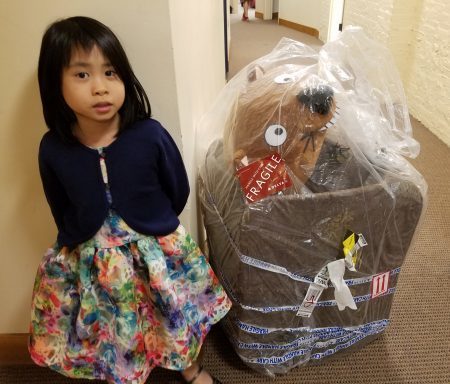
Heidi Hu and wombat themed costumes, photo by D. Kessler
Their paper was presented at the 71st Annual Meeting of the APS Division of Fluid Dynamics.
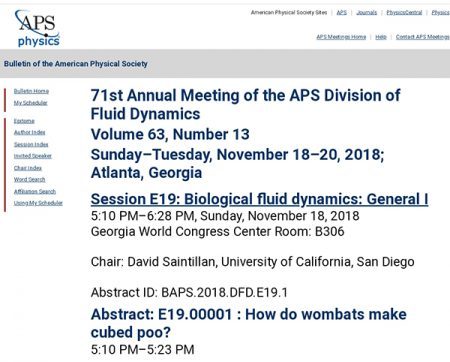
Here, for reference (but not for scale), is a photo of a wombat:

Wombat photo by Sharon Wormleaton © State of New South Wales and Office of Environment and Heritage

September 20, 2019
3-D printed lizards, monitored from high above by drones
Anole Annals tells of current research work—involving aerial drones and non-aerial 3-D printed lizards—by Emma Higgins of the University of Nottingham:
Anoles and Drones, a Dispatch from Island Biology 2019
… Emma’s work involves collecting data both at anole-level as well as above the canopy. She uses a DJI Phantom 4 drone platform fitted with a near-infrared camera to estimate a normalized difference vegetation index (NDVI, a measure of “greenness”) of the forest canopy across habitats, and found that just NDVI explains 28% of the spatial heterogeneity of lizard operative temperatures (in a mixed-model framework). This suggests that her drone can identify suitable thermal environments for lizards from above the canopy. I should mention that her resolution here is 4cm/pixel! She plans to zoom out to space and test whether similar imagery from the Sentinel 2 satellite will also be useful. Below the canopy, Emma is using LIDAR to simultaneously conduct forest shade modeling (for super fine-scale temporal variation in thermal microhabitat). LIDAR also detects perch availability, as it detects tree trunks very well. Emma also uses 3D printing to produce hundreds of anole models, each fitted with an iButton® temperature recorder and placed on perches in the forest. Each lizard print takes 52 minutes, so Emma ended up taking the printer to her flat to print 24/7 in preparation for her field season!

Marc Abrahams's Blog
- Marc Abrahams's profile
- 14 followers




